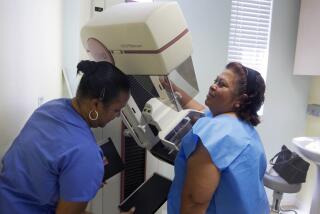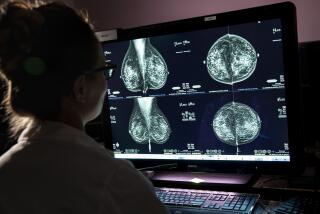Looking for clues about the dangerous breast cancers that turn up between mammograms
With any luck, a screening mammogram that shows no sign of breast cancer means you won’t have to think about the disease until it’s time for your next exam. But about 15% of breast cancers turn up in that interval between regular screenings.
These cases are troubling — and not just because the mammogram failed to catch the tumor before it had grown large enough to cause symptoms.
Breast cancers that are diagnosed between mammograms tend to grow more rapidly than cancers that are detected through screening. That’s why they’re able to go from nonexistent to producing signs of illness in a short period of time.
It also means these cancers are more dangerous.
Researchers have been trying to identify women who are susceptible to these “interval breast cancers” and find ways to reduce their risk. A study published Thursday in the journal JAMA Oncology offers some clues.
A team of doctors and scientists led by Anne Marie McCarthy, a cancer epidemiologist at Massachusetts General Hospital, reviewed the cases of 306,028 women who got screening mammograms between 2011 and 2014. All of the women were at least 40 years old, and none had been diagnosed with breast cancer before they had their exams.
The vast majority of these women — nearly 9 out of 10 — were told that their mammograms were negative, meaning there was nothing to indicate a tumor was present.
However, 160 of these women wound up being diagnosed with breast cancer in the 12 months following their test. Among them were 70 women whose cancers were considered to have a “poor prognosis,” according to the study.
Cancers were considered to have a poor prognosis if they had already spread to a regional lymph node or had metastasized to a more distant organ. They also got this designation based on their hormone receptor status. (They qualified if they were estrogen receptor-positive and/or progesterone receptor-positive and HER-2 negative invasive cancers at least 2 centimeters in diameter, triple-negative invasive cancers at least 1 cm in diameter, or HER2-positive invasive cancers at least 1 cm in diameter.)
Among all the women diagnosed with breast cancer within a year of their mammogram, those who had received an “all clear” were significantly more likely to have a poor prognosis than those whose cancers were caught via screening, the researchers found. In the former group, 44% of breast cancers had a poor prognosis; in the latter group, 27% did.
McCarthy and her colleagues took a closer look at the large group of women who had negative mammograms to see if they could identify risk factors associated with more serious breast cancers.
They found that women with dense breasts were twice as likely to be diagnosed with any kind of breast cancer in that first year than were women with non-dense breasts. But there was no significant association between breast density and the risk of a poor prognosis.
Next, they focused on the 160 women who were diagnosed with breast cancer after a negative mammogram. Age was linked with the risk of a poor prognosis, they found — women in their 40s were 3.5 times more likely to get this bad news than women in their 70s or 80s.
Once again, there was no significant link between breast density and the risk of a poor prognosis. A family history of breast cancer didn’t seem to play a role either.
It’s important to note that being diagnosed with any kind of breast cancer within a year of a negative mammogram was rare, affecting 5.9 out of every 10,000 women in the study. For the sake of comparison, study participants with positive mammogram results were diagnosed at a rate of 476.1 per 10,000.
“Although the rate of breast cancer after negative mammography results is small, the likelihood that such cases will be associated with a poor prognosis highlights the need to improve early detection for these women,” the study authors concluded.
Follow me on Twitter @LATkarenkaplan and “like” Los Angeles Times Science & Health on Facebook.
MORE IN SCIENCE
If you’re worried about prescription opioids, you should be really scared of fentanyl
Can you skip your regular workout and just shiver instead?







